The Cambridge History of China. Vol. 06. Alien Regimes and Border States, 907-1368
Подождите немного. Документ загружается.

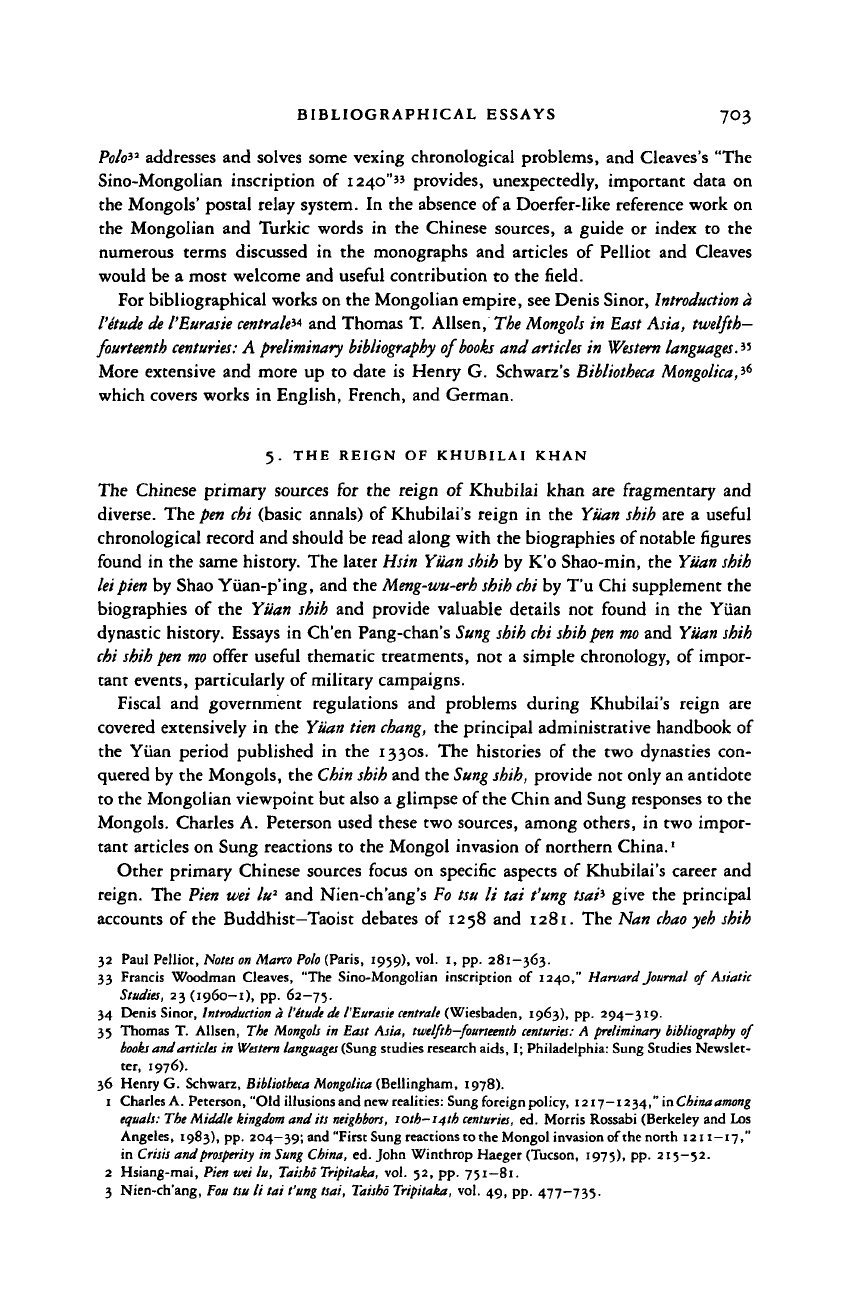
BIBLIOGRAPHICAL ESSAYS 703
Polo*
2
addresses and solves some vexing chronological problems, and Cleaves's "The
Sino-Mongolian inscription of 1240"" provides, unexpectedly, important data on
the Mongols' postal relay system. In the absence of
a
Doerfer-like reference work on
the Mongolian and Turkic words in the Chinese sources, a guide or index to the
numerous terms discussed in the monographs and articles of Pelliot and Cleaves
would be a most welcome and useful contribution to the field.
For bibliographical works on the Mongolian empire, see Denis Sinor,
Introduction
a
I'etude
de I'Eurasie
centrale*
and Thomas T. Allsen, The
Mongols
in East Asia, twelfth-
fourteenth
centuries:
A preliminary
bibliography
of
books
and
articles
in
Western
languages."
More extensive and more up to date is Henry G. Schwarz's
Bibliotheca
Mongolica,
i6
which covers works in English, French, and German.
5. THE REIGN OF KHUBILAI KHAN
The Chinese primary sources for the reign of Khubilai khan are fragmentary and
diverse. The pen chi (basic annals) of Khubilai's reign in the Yuan shih Ate a useful
chronological record and should be read along with the biographies of notable figures
found in the same history. The later Hsin Yuan shih by K'o Shao-min, the Yuan shih
lei pien
by Shao Yuan-p'ing, and the
Meng-wu-erh
shih chi by T'u Chi supplement the
biographies of the Yuan shih and provide valuable details not found in the Yuan
dynastic history. Essays in Ch'en Pang-chan's Sung shih chi shih
pen mo
and Yuan shih
chi shih
pen
mo offer useful thematic treatments, not a simple chronology, of impor-
tant events, particularly of military campaigns.
Fiscal and government regulations and problems during Khubilai's reign are
covered extensively in the Yuan tien
chang,
the principal administrative handbook of
the Yuan period published in the 1330s. The histories of the two dynasties con-
quered by the Mongols, the Chin shih and the
Sung
shih, provide not only an antidote
to the Mongolian viewpoint but also a glimpse of the Chin and Sung responses to the
Mongols. Charles A. Peterson used these two sources, among others, in two impor-
tant articles on Sung reactions to the Mongol invasion of northern China.'
Other primary Chinese sources focus on specific aspects of Khubilai's career and
reign. The Pien wei lu
2
and Nien-ch'ang's Fo tsu li tai t'ung tsafi give the principal
accounts of the Buddhist—Taoist debates of 1258 and 1281. The Nan
chao
yeh shih
32 Paul Pelliot, Notes
on
Marco
Polo
(Paris, 1959), vol. 1, pp. 281-363.
33 Francis Woodman Cleaves, "The Sino-Mongolian inscription of 1240," Harvard
Journal
of Asiatic
Studies, 23 (1960—1), pp. 62—75.
34 Denis Sinor,
Introduction
a
I'itude
de
I'Eurasie
centrale
(Wiesbaden, 1963), pp. 294—319.
35
Thomas
T.
Allsen,
The
Mongols
in
East Asia, twelfth—fourteenth centuries:
A
preliminary bibliography
of
books
and articles in
Western languages
(Sung studies research aids, I; Philadelphia: Sung Studies Newslet-
ter, 1976).
36 Henry G. Schwarz, Bibliotheca Mo»go/«» (Bellingham, 1978).
1 CharlesA. Peterson, "Old illusions and new realities: Sung foreign policy, 1217—1234," inChinaamong
equals: The Middle
kingdom
and its
neighbors,
toth-i^th
centuries,
ed. Morris Rossabi (Berkeley and Los
Angeles, 1983),
pp.
204—39;
and
"First Sung reactions
to the
Mongol invasion of the north 1211—17,"
in Crisis and prosperity
in
Sung China,
ed.
John Winthrop Haeger (Tucson, 1975),
pp.
215—52.
2 Hsiang-mai, Pienweilu, TaishoTripitaka,
vol. 52, pp.
751—81.
3
Nien-ch'ang,
Fou
tsu li tai t'ung tsai,
Taisho
Tripitaka, vol. 49, pp. 477—735.
Cambridge Histories Online © Cambridge University Press, 2008

704 BIBLIOGRAPHICAL ESSAYS
(translated by Camille Sainson)* describes Khubilai's campaign in Yunnan before he
assumed leadership of the Mongolian world. Specialized texts deal with the Yiian
dynasty's important relations with Korea
(Yiian Kao-li chi
shih),*
its grain tax policies
(Ta Yiian
ts'ang
k'u
chi),
6
its horse administration (Ta Yiian ma
cheng
chi),
1
and its
innovations in sea transport
(Ta Yiian
hai
yiin
chi).
9
The writings of such prominent
Yiian officials and cultural figures as Chao Meng-fu yield insights into and anecdotes
about the personalities, both Chinese and Mongolian, who played a vital role during
Khubilai's reign.
Because the Yiian was part of a larger Mongolian world, the writings of foreign
historians and travelers are invaluable sources. The contemporary observations of the
Persian historians JuvainI, Rashld al-Dln, and JuzjanI (the first two translated into
English by John A. Boyle and the third by H. G. Raverty)
9
offer perceptive and
unique accounts of Khubilai's court, and the Korean chronicle, Chong In-ji's
Koryd-
sa
completed in 1451, provides an indispensable record of the Yiian's relations with a
land that had frequent and extended contacts with China. The works of Christian
envoys to the Mongolian domains are conveniently translated in Christopher Daw-
son's The
Mongol
mission'
0
and by William Rockhill in
The journey
of William of
Rubruck
to the
eastern parts
of
the
world.
11
Marco Polo, the most renowned European
traveler to China in this era, offers an unsurpassed description of Khubilai's reign at
its height. The translation of
Marco's
work by A. C. Moule and Paul Pelliot,
Marco
Polo:
The
description
of
the
world,"
supplemented by their extensive (separately pub-
lished) notes
1
' and by Leonardo Olschki's
Marco Polo's
Asia,
•«
supply a remarkable
portrait of Khubilai, his court, and the China of
his
time. The Mongolian chronicle,
the
Chaghan
teiike,'*
offers what purports to be a combination of shamanist and
Buddhist views of Khubilai and his ancestors. Later Mongolian chronicles such as the
Allan
Tobchi,
16
are so imbued with Buddhism that they cannot be accepted as
unbiased, accurate accounts. The Tibetan account, the Blue
annals,
•' the Syriac
record of Bar Hebraeus,
18
and the Armenian description of King Het'um's travels'
9
are useful, though not as significant as the other more detailed foreign chronicles.
4 Camille Sainson, Nan-tcbao
ye-che,
bistoinparticuliirt de Nan-ubao (Paris, 1904).
5 Anon., Yuan Kao-li chi shih, in Shih liao u'ungpicn,
ssu-pien
(Taipei, 1972).
6 Anon., Ta Yiian Wang k'u chi, in Shih liao u'ung pirn,
ssu-pien
(Taipei, 1972).
7 Anon., Ta Yuan ma
cheng
chi, in Shih liao ts'ungpien,
ssu-pien
(Taipei, 1972).
8 Anon., Ta Yiian hai yiin chi, in Shih liao ts'ungpien, ssu-pien, ed. Hu Ching (Taipei, 1972).
9 See "Bibliographic Note for Chapter 4," nn. 8—13.
10 Christopher Dawson, ed., The Mongol mission: Narratives and letters of the
Franciscan missionaries
in
Mongolia and China in the
thirteenth
and
fourteenth centuries
(New York, 1935).
11 William Rockhill, The journey of William of
Rubruck
to the
eastern
parts of
the
world (London, 1900).
12 A. C. Moule and Paul Pelliot,
Marco
Polo: The
description
of the world (London, 1938).
13 A. C. Moule, Quinsai, with other
notes
on Marco Polo (Cambridge, 1957); and Paul Pelliot,
Notes
on
Marco Polo, 3 vols. (Paris, 1958-73).
14 Leonardo Olschki, Marco
Polo's
Asia (Berkeley, i960).
15 Klaus Sagaster, trans., Die
tutisse
Geschichte(Wiesbaden, 1976).
16 Charles R. Bawden, trans., The
Mongol chronicle
Allan
Tobci
(Wiesbaden, 1955).
17 George Roerich, trans., The blue annals, 2nd ed. (Delhi, 1976).
18 Wallis Budge, trans., The
chronography
of
Gregory
Abu 'I Faraj the
son
of Aaron, the
Hebrew
physician
commonly
known as Bar
Hebraeus,
2 vols. (London, 1932).
19 The description was explicated by John Andrew Boyle in "The journey of Het'um, king of Little
Armenia, to the court of the great khan Mb'ngke," Central Asiatic
Journal,
9 (1964), pp. 175-89.
Cambridge Histories Online © Cambridge University Press, 2008
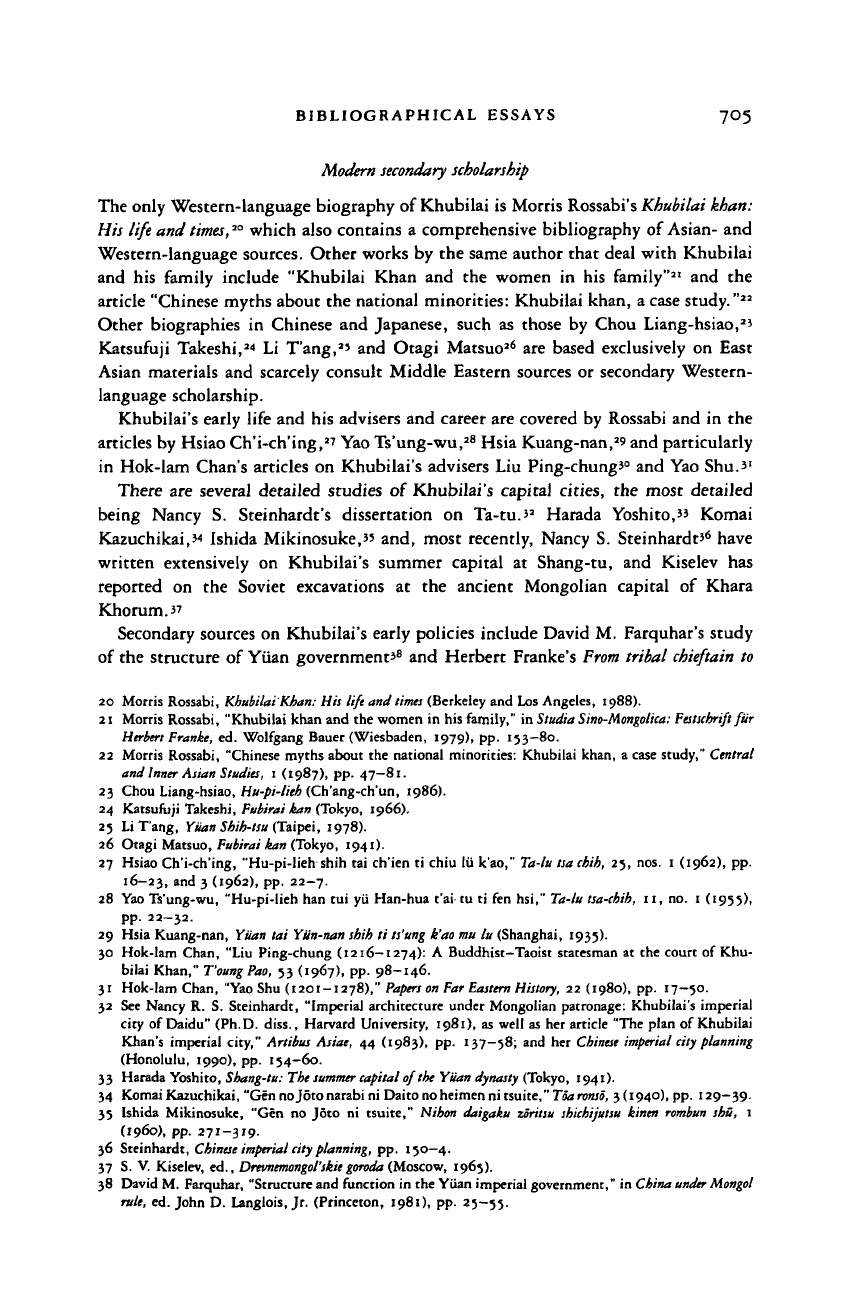
BIBLIOGRAPHICAL ESSAYS
705
Modem secondary scholarship
The only Western-language biography of Khubilai is Morris Rossabi's
Khubilai
khan:
His
life
and
times,
2
°
which also contains
a
comprehensive bibliography of
Asian-
and
Western-language sources. Other works by the same author that deal with Khubilai
and
his
family include "Khubilai Khan
and the
women
in his
family"
21
and the
article "Chinese myths about the national minorities: Khubilai khan, a case study."
22
Other biographies
in
Chinese and Japanese, such
as
those
by
Chou Liang-hsiao,
23
Katsufuji Takeshi,
2
''
Li
T'ang,
2
' and Otagi Matsuo
26
are based exclusively
on
East
Asian materials and scarcely consult Middle Eastern sources
or
secondary Western-
language scholarship.
Khubilai's early life and his advisers and career are covered by Rossabi and
in the
articles by Hsiao Ch'i-ch'ing,
27
Yao
Ts'ung-wu,
28
Hsia Kuang-nan,
2
' and particularly
in Hok-lam Chan's articles
on
Khubilai's advisers Liu Ping-chung
3
° and Yao
Shu.3'
There are several detailed studies
of
Khubilai's capital cities,
the
most detailed
being Nancy
S.
Steinhardt's dissertation
on
Ta-tu.
32
Harada Yoshito,
33
Komai
Kazuchikai,
34
Ishida Mikinosuke,
35
and, most recently, Nancy S. Steinhardt
36
have
written extensively
on
Khubilai's summer capital
at
Shang-tu,
and
Kiselev
has
reported
on the
Soviet excavations
at the
ancient Mongolian capital
of
Khara
Khorum.
37
Secondary sources on Khubilai's early policies include David M. Farquhar's study
of the structure of Yuan government
38
and Herbert Franke's
From tribal chieftain
to
20 Morris Rossabi, Khubilai Khan: His life and
limes
(Berkeley and Los Angeles, 1988).
21 Morris Rossabi, "Khubilai khan and the women
in
his family," in Studia Sino-Mmgolica:
Festschrift
fur
Herbert
Franke,
ed.
Wolfgang Bauer (Wiesbaden, 1979), pp. 153—80.
22 Morris Rossabi, "Chinese myths about
the
national minorities: Khubilai khan,
a
case study," Central
and
Inner
Asian Studies,
1
(1987),
pp.
47—81.
23 Chou Liang-hsiao, Hu-pi-lieh (Ch'ang-ch'un, 1986).
24 Katsufuji Takeshi, Fubirai kan (Tokyo, 1966).
25
Li
T'ang, Yiian Shih-tsu (Taipei, 1978).
26 Otagi Matsuo, Fubirai kan (Tokyo, 1941).
27 Hsiao Ch'i-ch'ing, "Hu-pi-lieh shih
tai
ch'ien
ti
chiu
lii
k'ao," Ta-lu tsa cbih,
25,
nos.
1
(1962),
pp.
16—23,
ar
>d
3
(1962), pp. 22—7.
28 Yao Ts'ung-wu, "Hu-pi-lieh han
tui yii
Han-hua
t'ai tu ti fen
hsi," Ta-lu tsa-chih,
11, no. 1
(1955),
pp.
22-32.
29 Hsia Kuang-nan, Yiian
tai
Yuri-nan shih
ti
ts'ung k'ao mu
lu
(Shanghai, 193;).
30 Hok-lam Chan, "Liu Ping-chung (1216—1274):
A
Buddhist-Taoist statesman
at the
court
of
Khu-
bilai Khan," T'oungPao,
53
(1967), pp. 98—146.
31 Hok-lam Chan, "Yao Shu (1201-1278),"
Papers on
Far
Eastern
History,
22
(1980),
pp.
17—50.
32 See Nancy
R. S.
Steinhardt, "Imperial architecture under Mongolian patronage: Khubilai's imperial
city
of
Daidu" (Ph.D. diss., Harvard University, 1981),
as
well
as
her article "The plan
of
Khubilai
Khan's imperial city," Artibus Asiae,
44
(1983),
pp.
137—58;
and her
Chinese
imperial city planning
(Honolulu, 1990), pp. 154-60.
3 3
Harada Yoshito, Shang-tu: The
summer
capital of
the
Yiian dynasty (Tokyo, 1941).
34 Komai Kazuchikai, "Gen nojotonarabi ni Daitonoheimenni tsuite," TiijrOTWi), 3(1940), pp. 129—39.
35 Ishida Mikinosuke, "Gen
no
Joto
ni
tsuite," Nihon daigaku zlritsu shichijutsu kinen
rombun
shu,
1
(i960), pp. 271-319.
36
Steinhardt,
Chinese
imperial city planning,
pp.
150—4.
37
S. V.
Kiselev,
ed.,
Drevnemmgol'skiegoroda
(Moscow, 1965).
38 David M. Farquhar, "Structure and function
in
the Yiian imperial government," in China
under Mongol
rule, ed. John
D.
Langlois, Jr. (Princeton, 1981),
pp.
25—55.
Cambridge Histories Online © Cambridge University Press, 2008
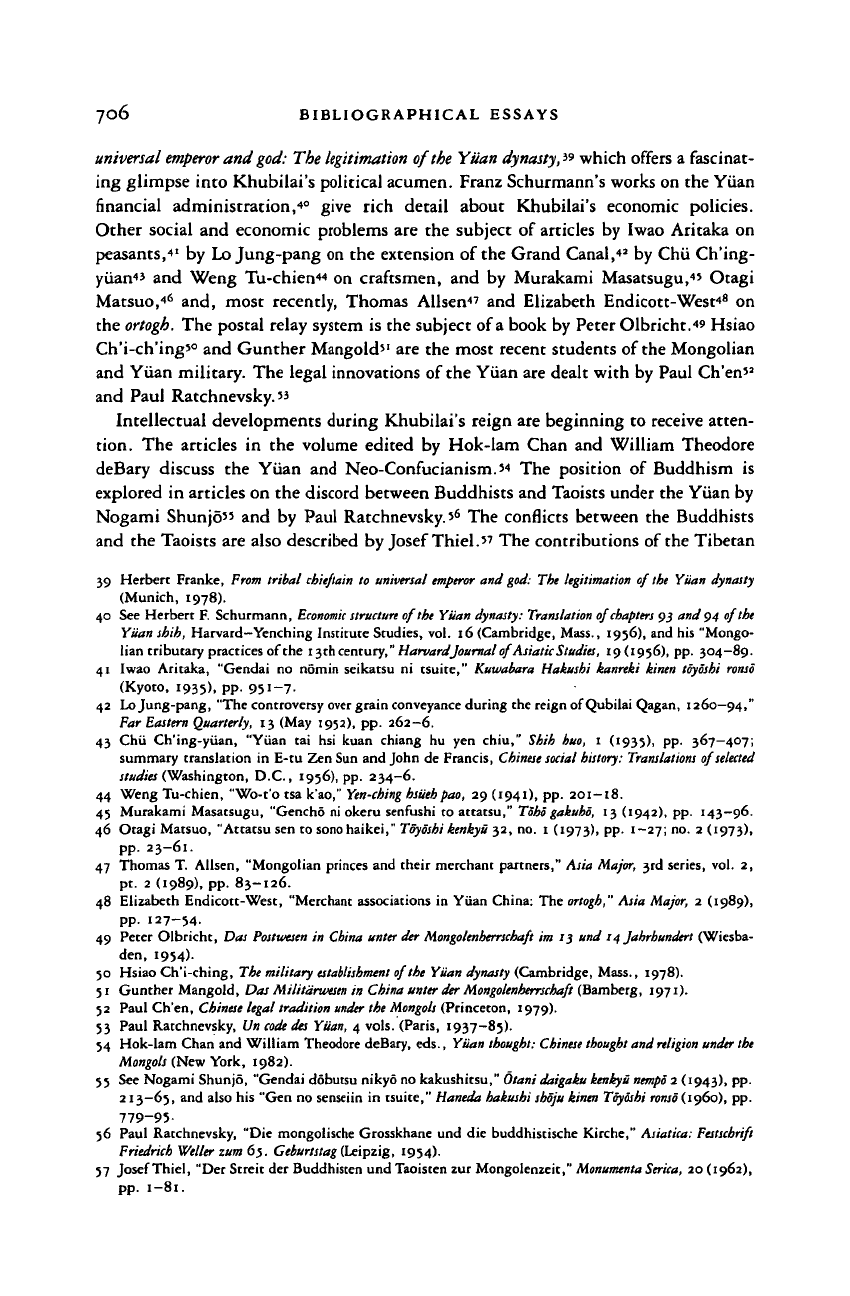
706
BIBLIOGRAPHICAL ESSAYS
universal emperor
and
god:
The
legitimation of the
Yuan dynasty,
i9
which offers
a
fascinat-
ing
glimpse into Khubilai's political acumen. Franz Schurmann's works on the Yuan
financial
administration,
40
give rich detail about Khubilai's economic policies.
Other
social
and
economic problems
are the
subject
of
articles
by
Iwao Aritaka
on
peasants,
4
'
by
Lo
Jung-pang on
the
extension
of
the Grand Canal,
42
by
Chii Ch'ing-
yiian
4
*
and
Weng Tu-chien
44
on
craftsmen,
and by
Murakami Masatsugu,
45
Otagi
Matsuo,
46
and,
most recently, Thomas Allsen
47
and
Elizabeth Endicott-Wesf
8
on
the
ortogh.
The postal relay system
is
the subject
of a
book by Peter Olbricht.
4
^ Hsiao
Ch'i-ch'ing'°
and
Gunther Mangold'
1
are
the
most recent students
of
the
Mongolian
and
Yuan military.
The
legal innovations
of
the Yuan are dealt with by Paul Ch'en'
2
and
Paul Ratchnevsky.
53
Intellectual
developments during Khubilai's reign are beginning
to
receive atten-
tion.
The
articles
in the
volume edited
by
Hok-lam Chan
and
William Theodore
deBary
discuss
the
Yuan
and
Neo-Confucianism.'
4
The
position
of
Buddhism
is
explored
in
articles
on
the discord between Buddhists and Taoists under the Yuan by
Nogami
Shunjo"
and by
Paul Ratchnevsky.'
6
The
conflicts between
the
Buddhists
and
the
Taoists
are
also described by Josef
Thiel."
The contributions
of
the Tibetan
39 Herbert Franke, From tribal
chief lain
to
universal
emperor
and
god:
The
legitimation
of
the
Yuan dynasty
(Munich,
1978).
40 See
Herbert
F.
Schurmann,
Economic structure
of the Yiian dynasty:
Translation
of
chapters
93 and
94 of the
Yuan shih, Harvard—Yenching Institute Studies,
vol. 16
(Cambridge, Mass., 1956),
and his
"Mongo-
lian tributary practices
of
the 13th century," Harvard Journal ofAsiatic
Studies,
19(1936),pp. 304-89.
41 Iwao Aritaka, "Gendai
no
nomin seikatsu
ni
tsuite," Kuwabara Hakushi kanreki kinen toyoshi
ronso
(Kyoto, 1935),
pp.
951-7-
42
Lo
Jung-pang, "The controversy over grain conveyance during
the
reign of Qubilai Qagan, 1260—94,"
Far
Eastern
Quarterly,
13 (May
1952),
pp.
262—6.
43 Chii Ch'ing-yiian, "Yiian
tai hsi
kuan chiang
hu yen
chiu," Shih huo,
1
(1935),
pp.
367-407;
summary translation
in E-tu Zen
Sun and John
de
Francis,
Chinese social
history:
Translations
of selected
studies (Washington,
D.C.,
1956),
pp.
234-6.
44 Weng Tu-chien, "Wo-t'o
tsa
k'ao,"
Yen-ching
hsiiehpao,
29
(1941),
pp.
201-18.
43 Murakami Masatsugu, "Gencho
ni
okeru senrushi
to
attatsu,"
Toho
gakuho,
13
(1942),
pp.
143—96.
46 Otagi Matsuo, "Attatsu
sen to
sono haikei,"
Toyoshi
tenkyu
32, no. 1
(1973),
pp. 1-27; no. 2
(1973),
pp.
23-61.
47 Thomas
T.
Allsen, "Mongolian princes
and
their merchant partners," Asia Major,
3rd
series,
vol. 2,
pt.
2
(1989),
pp.
83-126.
48 Elizabeth Endicott-West, "Merchant associations
in
Yiian China:
The
ortogh,"
Asia Major,
2
(1989),
pp.
127-54.
49 Peter Olbricht,
Das
Postwesen
in
China
unter
der
Mongolenhemchaft
im 13 und
14 Jahrhundert
(Wiesba-
den, 1954).
50
Hsiao Ch'i-ching, The military
establishment
of the Yiian dynasty (Cambridge, Mass., 1978).
51 Gunther Mangold,
Das
Milita'rwesm
in
China
unter
der
Mongolenherrschafi
(Bamberg, 1971)-
52 Paul Ch'en,
Chinese
legal tradition
under
the
Mongols
(Princeton, 1979).
53 Paul Ratchnevsky, Un
code des
Yiian,
4
vols. (Paris, 1937-85).
54 Hok-lam Chan
and
William Theodore deBary,
eds.,
Yiian
thought:
Chinese thought
and
religion under the
Mongols
(New
York, 1982).
55
See
Nogami Shunjo, "Gendai dobutsu nikyo
no
kakushitsu," Otani daigaku
kenkyu nempo
2
(1943),
pp.
213—65,
and
also
his "Gen no
senseiin
in
tsuite," Haneda
hakushi shoju kinen Toyoshi ronso
(i960),
pp.
779-95-
56 Paul Ratchnevsky,
"Die
mongolische Grosskhane
und die
buddhistische Kirche," Asiatica:
Festschrift
Friedrich Weller zum
65.
Geburtstag (Leipzig, 1954).
57 Josef Thiel, "Der Streit
der
Buddhisten
und
Taoisten
zur
Mongolenzeit,"
Monumenta
Sirica,
20
(1962),
pp.
1-81.
Cambridge Histories Online © Cambridge University Press, 2008
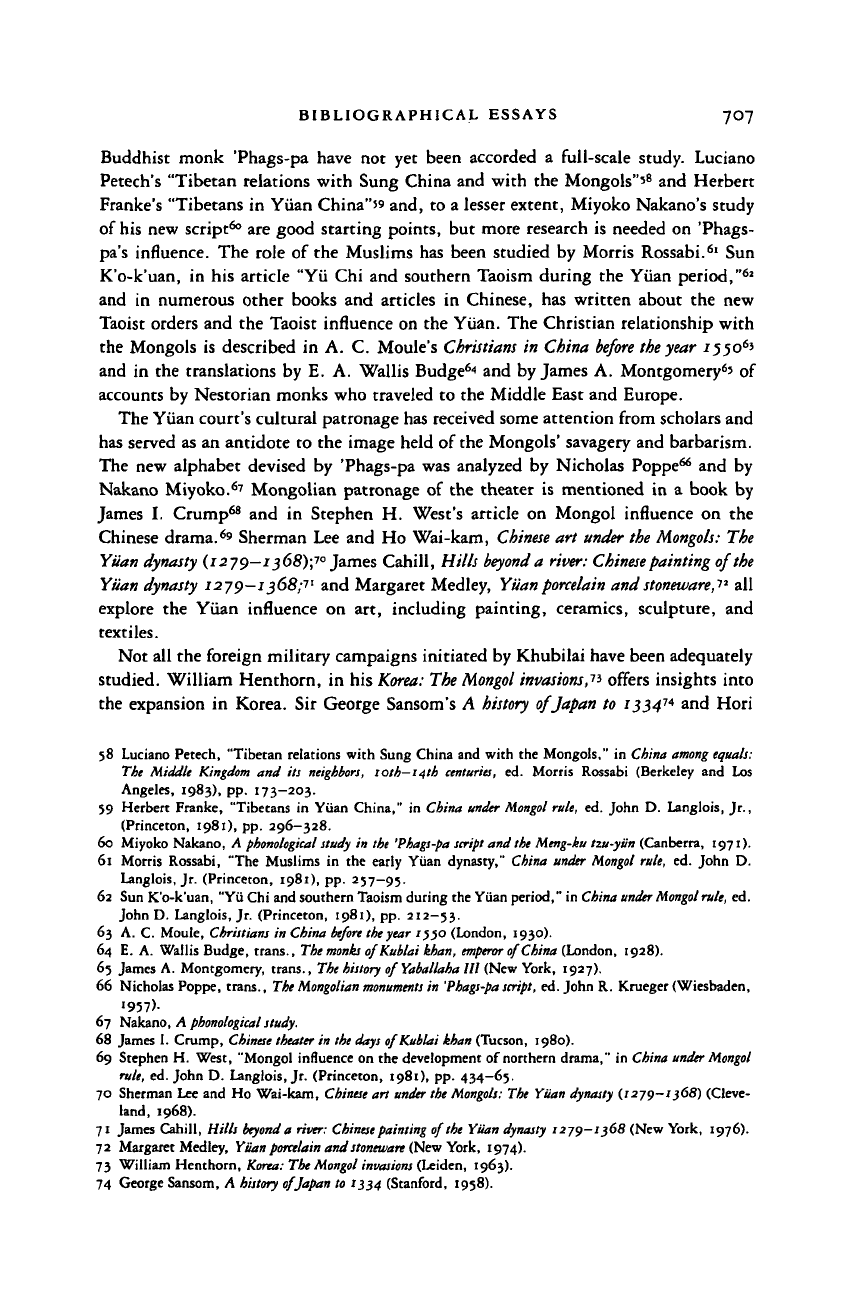
BIBLIOGRAPHICAL ESSAYS 707
Buddhist monk "Phags-pa have not yet been accorded a full-scale study. Luciano
Petech's "Tibetan relations with Sung China and with the Mongols"'
8
and Herbert
Franke's "Tibetans in Yuan China"" and, to a lesser extent, Miyoko Nakano's study
of his new script
60
are good starting points, but more research is needed on 'Phags-
pa's influence. The role of the Muslims has been studied by Morris Rossabi.
61
Sun
K'o-k'uan, in his article "Yii Chi and southern Taoism during the Yuan period,"
62
and in numerous other books and articles in Chinese, has written about the new
Taoist orders and the Taoist influence on the Yuan. The Christian relationship with
the Mongols is described in A. C. Moule's Christians in China
before
the year 15^0^
and in the translations by E. A. Wallis Budge
6
* and by James A. Montgomery
6
' of
accounts by Nestorian monks who traveled to the Middle East and Europe.
The Yuan court's cultural patronage has received some attention from scholars and
has served as an antidote to the image held of the Mongols' savagery and barbarism.
The new alphabet devised by 'Phags-pa was analyzed by Nicholas Poppe
66
and by
Nakano Miyoko.
67
Mongolian patronage of the theater is mentioned in a book by
James I. Crump
68
and in Stephen H. West's article on Mongol influence on the
Chinese drama.
6
' Sherman Lee and Ho Wai-kam,
Chinese
art under the
Mongols:
The
Yuan dynasty (1279-2368);
70
James Cahill, Hills
beyond
a
river:
Chinese painting of the
Yuan dynasty 12J9—1368;
7
' and Margaret Medley, Yuan
porcelain
and
stoneware,''
2
all
explore the Yuan influence on art, including painting, ceramics, sculpture, and
textiles.
Not all the foreign military campaigns initiated by Khubilai have been adequately
studied. William Henthorn, in his
Korea:
The
Mongol
invasions,
1
*
offers insights into
the expansion in Korea. Sir George Sansom's A history of Japan to 1334™ and Hori
58 Luciano Petech, "Tibetan relations with Sung China and with the Mongols," in China
among
equals:
The Middle Kingdom and its neighbors, 10th—14th
centuries,
ed. Morris Rossabi (Berkeley and Los
Angeles, 1983), pp. 173-203.
59 Herbert Franke, "Tibetans in Yuan China," in China under Mongol rule, ed. John D. Langlois, Jr.,
(Princeton, 1981), pp. 296-328.
60 Miyoko Nakano, A
phonological
study in the
'Phags-pa script
and
the
Meng-ku tzu-yun (Canberra, 1971).
61 Morris Rossabi, "The Muslims in the early Yuan dynasty," China under Mongol rule, ed. John D.
Langlois, Jr. (Princeton, 1981), pp. 257-95.
62 Sun K'o-k'uan, "Yu Chi and southern Taoism during the Yuan period," in China
under Mongol
rule,
ed.
John D. Langlois, Jr. (Princeton, 1981), pp. 212—53.
63 A. C. Moule, Christians in China
before the
year 1550 (London, 1930).
64 E. A. Wallis Budge, trans., The
monks
of Kublai khan,
emperor
of China (London, 1928).
65 James A. Montgomery, trans., The history of Yaballaha III (New York, 1927).
66 Nicholas Poppe, trans., The
Mongolian monuments
in
'Phags-pa
script,
ed. John R. Krueger (Wiesbaden,
'957>-
67 Nakano, A
phonological
study.
68 James I. Crump,
Chinese
theater in the days of Kublai khan (Tucson, 1980).
69 Stephen H. West, "Mongol influence on the development of northern drama," in China
under Mongol
rule, ed. John D. Langlois, Jr. (Princeton, :98i), pp. 434—65.
70 Sherman Lee and Ho Wai-kam,
Chinese
art
under
the
Mongols:
The Yuan dynasty (1279-1368) (Cleve-
land, 1968).
71 James Cahill, Hills
beyond
a river:
Chinese
painting of
the
Yuan dynasty 1279—1368 (New York, 1976).
72 Margaret Medley, Yuan
porcelain
and
stoneware
(New York, 1974).
73 William Henthorn, Korea: The Mongol
invasions
(Leiden, 1963).
74 George Sansom, A history of Japan to 1334 (Stanford, 1958).
Cambridge Histories Online © Cambridge University Press, 2008
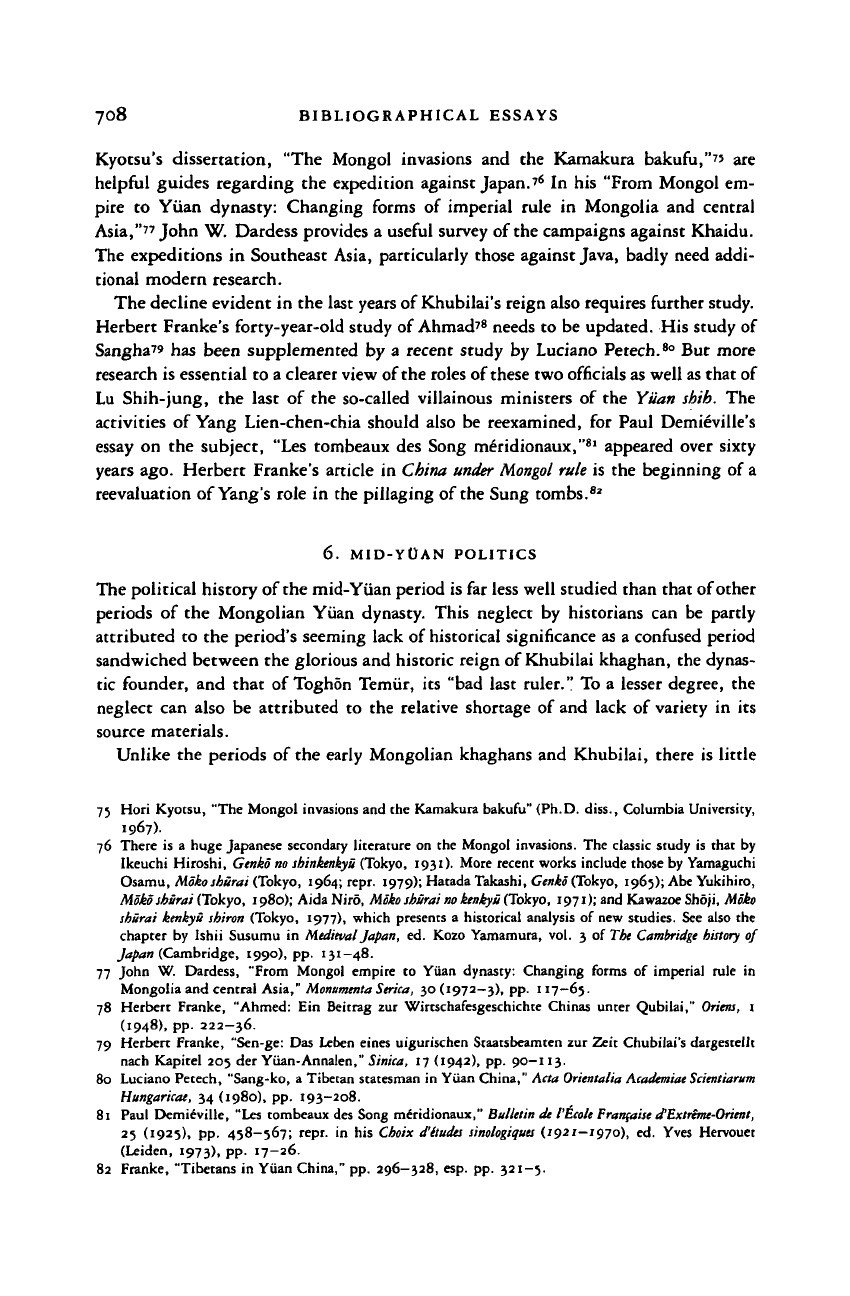
708 BIBLIOGRAPHICAL ESSAYS
Kyotsu's dissertation, "The Mongol invasions and the Kamakura bakufu,"
7
' are
helpful guides regarding the expedition against Japan.'
6
In his "From Mongol em-
pire to Yuan dynasty: Changing forms of imperial rule in Mongolia and central
Asia,"
77
John W. Dardess provides a useful survey of the campaigns against Khaidu.
The expeditions in Southeast Asia, particularly those against Java, badly need addi-
tional modern research.
The decline evident in the last years of Khubilai's reign also requires further study.
Herbert Franke's forty-year-old study of Ahmad
78
needs to be updated. His study of
Sangha
79
has been supplemented by a recent study by Luciano Petech.
80
But more
research is essential to a clearer view of
the
roles of
these
two officials as well
as
that of
Lu Shih-jung, the last of the so-called villainous ministers of the Yuan
shih.
The
activities of Yang Lien-chen-chia should also be reexamined, for Paul Demieville's
essay on the subject, "Les tombeaux des Song meiidionaux,"
81
appeared over sixty
years ago. Herbert Franke's article in
China under Mongol rule
is the beginning of a
reevaluation of Yang's role in the pillaging of the Sung tombs.
82
6. MID-YOAN POLITICS
The political history of the mid-Yuan period is far less well studied than that of other
periods of the Mongolian Yuan dynasty. This neglect by historians can be partly
attributed to the period's seeming lack of historical significance as a confused period
sandwiched between the glorious and historic reign of Khubilai khaghan, the dynas-
tic founder, and that of Toghon Temiir, its "bad last ruler." To a lesser degree, the
neglect can also be attributed to the relative shortage of and lack of variety in its
source materials.
Unlike the periods of the early Mongolian khaghans and Khubilai, there is little
75 Hori Kyotsu, "The Mongol invasions and the Kamakura bakufu" (Ph.D. diss., Columbia University,
1967).
76 There is a huge Japanese secondary literature on the Mongol invasions. The classic study is that by
Ikeuchi Hiroshi, Genko
no
shinkenkyu
(Tokyo, 1931). More recent works include those by Yamaguchi
Osamu, Mokoshurai (Tokyo, 1964; repr. 1979); HatadaTakashi,
Genko
(Tokyo, 1965); Abe Yukihiro,
MSkoshiirai (Tokyo, 1980); AidaNiro,
Moko
shurai
no
kenkyu
(Tokyo, 1971); and Kawazoe Shoji, Moko
thurai kenkyu shiron (Tokyo, 1977), which presents a historical analysis of new studies. See also the
chapter by Ishii Susumu in Medieval Japan, ed. Kozo Yamamura, vol. 3 of The Cambridge history of
Japan (Cambridge, 1990), pp. 131—48.
77 John W. Dardess, "From Mongol empire to Yuan dynasty: Changing forms of imperial rule in
Mongolia and central Asia,"
Monumenla
Serica,
30 (1972-3), pp. 117—65.
78 Herbert Franke, "Ahmed: Ein Beitrag zur Wirtschafesgeschichte Chinas unter Qubilai," Oriens, 1
(1948),
pp. 222-36.
79 Herbert Franke, "Sen-ge: Das Leben eines uigurischen Staatsbeamten zur Zeit Chubilai's dargestellt
nach Kapitel 205 der Yiian-Annalen," Sinica, 17 (1942), pp. 90-113.
80 Luciano Petech, "Sang-ko, a Tibetan statesman in Yuan China," Acta Orientalia
Academiae Scientiarum
Hungaricae, 34 (1980), pp. 193-208.
81 Paul Demieville, "Les tombeaux des Song meridionaux," Bulletin de
1't.cole
Franfaise
d"Exlreme-Orimt,
25 (1925), pp. 458—567; repr. in his Choix d'itudcs
sinologiques
(1921—1970), ed. Yves Hervouet
(Leiden, 1973), pp. 17—26.
82 Franke, "Tibetans in Yuan China," pp. 296-328, esp. pp. 321-5.
Cambridge Histories Online © Cambridge University Press, 2008

BIBLIOGRAPHICAL ESSAYS 709
surviving historical material concerning the period in the Mongolian and Western
languages. Of the Persian sources, Rashld al-DIn's Jami'
al-Tavarikh,
"Collection of
chronicles," which is invaluable to the study of the history of the early Mongolian
empire as a whole, covers the period only up to the reign of Temiir khaghan. This
account of Temiir's reign is now available
in
J.
A. Boyle's English translation
1
as well
as in Russian and Chinese translations. For the post-Temiir period, al-Qashanl's
Tartkh-f Uljaytu, "History of Oljeitu,"
2
and Wassaf's Tankh-i
Wassaf,
" Wassaf's
history,"' are available only in the Persian originals and are useful mainly for the
study of Yiian's relation with the western khanates. The study of
the
political history
of the mid-Yiian, therefore, depends mainly on Chinese sources.
Of the Chinese sources,
the pen chi
(basic annals) of various reigns and the biogra-
phies of the important figures of the period in the Yiian shih are the basic and
indispensable sources for reconstructing the political history of the period. As an
official history hastily put together at the beginning of
the
succeeding Ming dynasty,
the
Yiian shih
is well known for its shortcomings.
4
Most of historians' criticisms of
the
Yiian shih
as a whole can be applied to the parts dealing with this period.
First, there are no biographies of the principal ministers of Khaishan's and Yesiin
Temiir's reigns. The accounts of the
Yiian
shih,
therefore, must be supplemented by
and corroborated with the relevant materials in the
uien-chi
(collected literary works)
of the authors of the mid- and late Yiian, many of whom were actively involved in
the government, as well as in the various later compilations of
Yiian
history by Shao
Yiian-p'ing,' T'u Chi,
6
and K'o Shao-min.
7
The most useful
wen-chi
for this period
include those by Chao Meng-fu, Ch'eng Chii-fu, Liu Min-chung, Chang Yang-hao,
Huang Chin, Yii Chi, Chieh Hsi-ssu, Ma Tsu-ch'ang, Su T'ien-chiieh, Ou-yang
Hsiian, Hsu Yu-jen, and Wei Su. The anthology
Kuo ch'ao wen
lei,
8
compiled by Su
T'ien-chiieh, also contains much material not available elsewhere; its coverage,
however, stops at the 1310s. Another compilation by Su T'ien-chiieh, Yiian
ch'ao
ming ch'en shih
liieh,*
the biographies of important officials from the beginning of the
Mongolian empire to Temiir's reign, is useful only for the early part of our period. Pi-
chi (collections of miscellaneous notes) by mid- and late-Yiian authors including
Ch'ang-ku Chen-i's
Nung
t'ien
yii hua,'° Yang Yii's
Shan chii hsin
hua,
11
K'ung Ch'i's
1 Rashld al-DIn,
The successors
of
Genghis
khan,
trans. John A. Boyle (New York, 1971).
2 Al-QashanI, Tartkh-t
Uljaytu,
ed. Mahin Hambly (Tehran, 1969).
3
Wassaf,
Tarikh-l
Wassaf,
lithograph ed. (Bombay, 1852-3), reedited by Mohammed Mahdi Isfahan!
(Tehran, 1959-60).
4 Sung Lien et al. eds.,
Yiian shih
(Peking,
1976)
(hereafter cited as YS).
5 Shao Yiian-p'ing,
Yiian shih
leipien,
Sao-yeh shan-fang ed.
6 T'u Chi,
Meng tvu erh shih
chi,
ed. Chieh-I-i (Peking, 1934).
7 K'o Shao-min, Hsin
Yiian shih
(Tientsin, 1922; author's 2nd rev. ed., Peking, 1930); repr. in
Erh shih
wu
shih,
ed. Erh shih wu shih k'an hsing wu yuan hui (Shanghai, 1935; repr. Taipei, 1962-9, and
other recent facsimile reprints) (hereafter cited at HYS).
8 Su Tien-chiieh, comp.,
Kuo ch'ao wen lei
(SPTK ed.).
9 Su T'ien-chiieh, comp.,
Yuan ch'ao ming ch'en shih
liieh,
(1335 ed.; repr. Peking, 1962).
10 Ch'ang-ku Chen-i,
Nung
t'ien
yii
hua
(Pao-yen t'ang pi chi ed.).
11 Yang Yu, Shan
chii hsin
hua (Chih pu tsu chai ts'ung shu ed.). It was translated into German by
Herbert Franke, Beitrage zur
Kulturgeschichte
Chinas unter der
fAongolenherrschaft
(Wiesbaden, 1956).
Cambridge Histories Online © Cambridge University Press, 2008

7IO BIBLIOGRAPHICAL ESSAYS
(K'ung K'e-ch'i)
Chih cheng chih
chi," and T'ao Tsung-i's
Nan ts'un ch'o keng
lit**
all are
occasionally useful as supplements to the
Yiian
shitis,
accounts.
For studying institutional developments, the
chih
(treatises) sections of the Yiian
shih are the most convenient source. The materials in the
chih,
however, must be
supplemented by such collections of basic documents as the Yuan
tien change
and
Tung chih
t'iao
ko,
l
>
whose coverage stops at 1322 and 1315, respectively. Other
useful basic materials for studying Yuan institutions include the surviving sections of
the
Ching shih
ta tien,
16
the institutional compendium compiled in
1330-1,
and the
several official compilations made in Toghon Temiir's reign. The latter include the
Hsien
t'ai
t'ung
chi'
7
and Nan t'ai
pet
yao,
lS
both of which deal with the Censorate, and
the Pi
shu chien
chih,
which deals with the Palace Library.'
9
The political history of the mid-Yuan received due attention in modern-style
histories only in recent years. The best political narrative can be found in the Yiian
ch'ao
shih.
2
° This was edited by Professor Han Ju-lin, the leading authority on the
Yiian history in China, but written by the staff members of the history department of
Nanking University, including the prominent Yiian historians Ch'en Te-chih and
Ch'iu Shu-shen. As a full-length modern historical account of
the
period, its publica-
tion in 1986 was an important milestone in the history of Yiian studies. An equally
useful account of Yiian politics can be found in the
Chung-kuo
t'ung
shih," which was
written by another team of Chinese Yiian experts, including Ts'ai Mei-piao, Chou
Liang-hsiao, and Chou Ch'ing-shu. Li Tse-fen's
Yiian shih hsin
chiang"
provides the
most lengthy, but not always
a
reliable, account of mid-Yuan politics.
Except for the narrative histories by d'Ohsson and Henry Howorth in the last
century, mid-Yiian politics did not receive the attention of Western scholars until the
publication of John Dardess's
Conquerors
and
Confucians^
seventeen years ago. Even
though he was concerned primarily with the political changes in Toghon Temiir's
reign, the author devoted the first two chapters of the book to the mid-Yiian as the
necessary background for his discussion of late-Yiian politics. Although disagreeing
with his main thesis that the restoration of Khaishan's imperial line in 1328 marked
the Yiian's irrevocable secession from steppe politics and the beginning of the
12
K'ung
Ch'i (K'ung K'e-ch'i),
Chih cheng chih
chi, invols. 321-4 of WuCh'ung-yao, ed., Yiiehyal'ang
ts'ung shu (repr. of 1853 ed.; Taipei, 1965).
13 T'ao Tsung-i, Nan tsung
ch'o keng
iu (Peking, 1958).
14 Ta Yiian
sbeng cheng
kuo
ch'ao
tien
cbang
(Yiian lien
chang)
(Yiian ed., repr. Taipei, 1973) (hereafter cited
as YTC).
15 A part of the t'iao-ko section of the Ta Yiian
t'ung
chih has survived and was reprinted in 1930 by the
National Peking Library under the title
T'ung
chih
t'iao
ko (Code of comprehensive institutions).
16 For a complete list, see Su Chen-shen, Yiian
cheng shu
Chin shih ta tien
chih yen chin
(Taipei, 1984), pp.
40-50, 64-74.
17 Hsien t'ai
t'ung
chi in Yung-lo ta tin (Peking, i960), chiian 2608-9.
18 Nan t'ai peiyao, in Yung-lo ta tien (Peking, i960), chiian
J6IO—11.
19 Pi shu
chien
chih (Kuang ts'ang hsiieh chiin ed.).
so Han Ju-lin, comp., Yiian
ch'ao
shih,
2 vols. (Peking, 1986).
21 Ts'ai Mei-piao, Chou Liang-hsiao, Chou Ch'ing-shu et al., Chung-kuo
t'ung
shih, vol. 7 (Peking,
1983)-
22 Li Tse-fen's Yiian shih hsin chiang, vol. 3 (Taipei, 1978).
23 John Dardess,
Conquerors
and
Confucians:
Aspects
of political
change
in late Yiian China (New York, 1973).
Cambridge Histories Online © Cambridge University Press, 2008
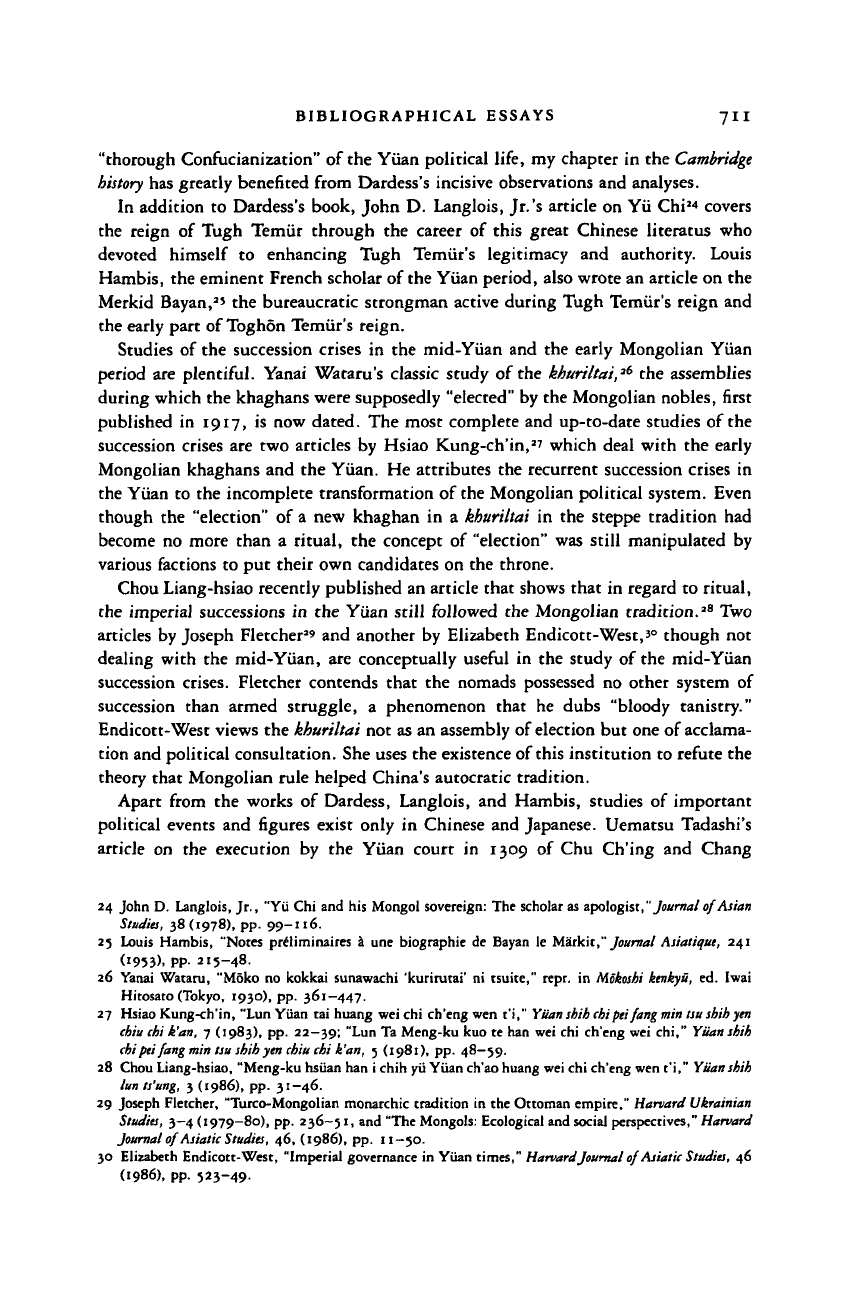
BIBLIOGRAPHICAL ESSAYS 711
"thorough Confiicianization" of the Yuan political life, my chapter in the
Cambridge
history
has greatly benefited from Dardess's incisive observations and analyses.
In addition
to
Dardess's book, John D. Langlois, Jr.'s article on Yii Chi
2
'' covers
the reign
of
Tugh Temiir through
the
career
of
this great Chinese literatus
who
devoted himself
to
enhancing Tugh Temiir's legitimacy
and
authority. Louis
Hambis, the eminent French scholar of the Yuan period, also wrote an article on the
Merkid Bayan,*
5
the bureaucratic strongman active during Tugh Temiir's reign and
the early part of Toghon Temiir's reign.
Studies
of
the succession crises
in the
mid-Yuan and the early Mongolian Yuan
period are plentiful. Yanai Wataru's classic study of the khuriltai,
26
the assemblies
during which the khaghans were supposedly "elected" by the Mongolian nobles, first
published
in
1917,
is
now dated. The most complete and up-to-date studies of the
succession crises are two articles
by
Hsiao Kung-ch'in,
37
which deal with the early
Mongolian khaghans and the Yuan. He attributes the recurrent succession crises
in
the Yuan
to
the incomplete transformation of the Mongolian political system. Even
though
the
"election"
of
a new khaghan
in a
khuriltai
in the
steppe tradition had
become
no
more than
a
ritual, the concept
of
"election" was still manipulated
by
various factions to put their own candidates on the throne.
Chou Liang-hsiao recently published an article that shows that
in
regard to ritual,
the imperial successions
in
the Yuan still followed the Mongolian tradition.
28
Two
articles by Joseph Fletcher
29
and another by Elizabeth Endicott-West,'
0
though not
dealing with the mid-Yuan, are conceptually useful
in the
study
of
the mid-Yiian
succession crises. Fletcher contends that
the
nomads possessed
no
other system
of
succession than armed struggle,
a
phenomenon that
he
dubs "bloody tanistry."
Endicott-West views the
khuriltai
not as an assembly of election but one of acclama-
tion and political consultation. She uses the existence of
this
institution to refute the
theory that Mongolian rule helped China's autocratic tradition.
Apart from
the
works
of
Dardess, Langlois,
and
Hambis, studies
of
important
political events and figures exist only
in
Chinese and Japanese. Uematsu Tadashi's
article
on the
execution
by the
Yuan court
in
1309
of
Chu Ch'ing
and
Chang
24 John D. Langlois, Jr., "Yii Chi and his Mongol sovereign: The scholar as apologist,"
Journal
ofAsian
Studies,
38 (1978), pp. 99-116.
25 Louis Hambis, "Notes preliminaires
a
une biographic
de
Bayan
le
M&rkit,"
Journal
Asiatique,
241
('953). PP- 215-48.
26 Yanai Wataru, "Moko
no
kokkai sunawachi 'kurirutai'
ni
tsuite," repr.
in
Mokoshi
kenkyu,
ed.
Iwai
Hitosato (Tokyo, 1930), pp. 361-447.
27 Hsiao Kung-ch'in, "Lun Yuan tai huang weichi ch'engwen t'i,"
Yuan shih chipeifangmin
tsushihyen
chiu chi
k'an,
7
(1983), pp. 22—39; "Lun Ta Meng-ku kuo
te
han wei chi ch'eng wei chi,"
Yuan shih
chi pei fang
min tsu shih yen chiu chi
k'an, 5 (1981), pp. 48—59.
28 Chou Liang-hsiao, "Meng-ku hsiian han i chih yii Yuan ch'ao huang wei chi ch'eng wen t'i,"
Yuan shih
lun
ts'ung,
3
(1986), pp. 31-46.
29 Joseph Fletcher, "Turco-Mongolian monarchic tradition in the Ottoman empire,"
Harvard Ukrainian
Studies,
3-4(1979-80), pp.
236-51,
and "The Mongols: Ecological and social perspectives,"
Harvard
Journal
of
Asiatic
Studies,
46, (1986), pp. n—50.
30 Elizabeth Endicott-West, "Imperial governance in Yuan times," Harvard
Journal
of
Asiatic
Studies,
46
(1986),
pp. 523-49.
Cambridge Histories Online © Cambridge University Press, 2008
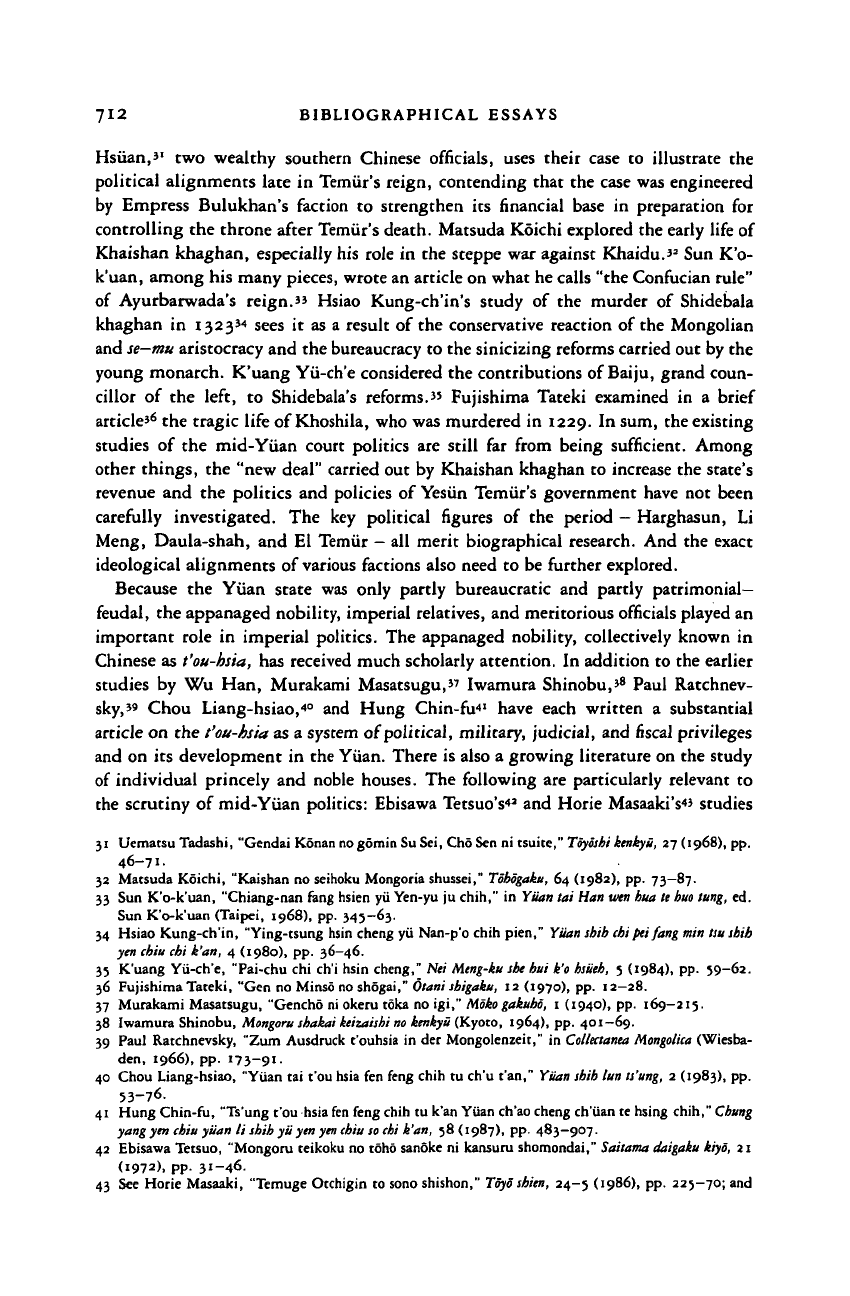
712 BIBLIOGRAPHICAL ESSAYS
Hsiian,'
1
two wealthy southern Chinese officials, uses theit case to illustrate the
political alignments late in Temiir's reign, contending that the case was engineered
by Empress Bulukhan's faction to strengthen its financial base in preparation for
controlling the throne after Temiir's death. Matsuda Koichi explored the early life of
Khaishan khaghan, especially his role in the steppe war against Khaidu.'
2
Sun K'o-
k'uan, among his many pieces, wrote an article on what he calls "the Confucian rule"
of Ayurbarwada's reign.» Hsiao Kung-ch'in's study of the murder of Shidebala
khaghan in 1323W sees it as a result of the conservative reaction of the Mongolian
and se—mu aristocracy and the bureaucracy to the sinicizing reforms carried out by the
young monarch. K'uang Yii-ch'e considered the contributions of Baiju, grand coun-
cillor of the left, to Shidebala's reforms." Fujishima Tateki examined in a brief
article'
6
the tragic life of Khoshila, who was murdered in 1229. In sum, the existing
studies of the mid-Yuan court politics are still far from being sufficient. Among
other things, the "new deal" carried out by Khaishan khaghan to increase the state's
revenue and the politics and policies of Yesiin Temiir's government have not been
carefully investigated. The key political figures of the period — Harghasun, Li
Meng,
Daula-shah, and El Temiir — all merit biographical research. And the exact
ideological alignments of various factions also need to be further explored.
Because the Yuan state was only partly bureaucratic and partly patrimonial-
feudal, the appanaged nobility, imperial relatives, and meritorious officials played an
important role in imperial politics. The appanaged nobility, collectively known in
Chinese as t'ou-hsia, has received much scholarly attention. In addition to the earlier
studies by Wu Han, Murakami Masatsugu,
37
Iwamura Shinobu,'
8
Paul Ratchnev-
sky,"
Chou Liang-hsiao,
4
° and Hung Chin-fu
41
have each written a substantial
article on the
t'ou-hsia
as a system of political, military, judicial, and fiscal privileges
and on its development in the Yuan. There is also a growing literature on the study
of individual princely and noble houses. The following are particularly relevant to
the scrutiny of mid-Yuan politics: Ebisawa TetsuoV* and Horie Masaaki's
4
' studies
31 Uematsu Tadashi, "Gendai Konan no gomin Su Sei, Cho Sen ni tsuite," Toyoibi ktnkyu, 27 (1968), pp.
46-71.
32 Matsuda Koichi, "Kaishan no seihoku Mongoria shussci," Tobogaku, 64 (1982), pp. 73—87.
33 Sun K'o-k'uan, "Chiang-nan fang hsien yii Yen-yu ju chih," in Yuan tai Han wen hua te
huo
lung, ed.
Sun K'o-k'uan (Taipei, 1968), pp. 345—63.
34 Hsiao Kung-ch'in, "Ying-tsung hsin cheng yii Nan-p'o chih pien," Yuan shib
chi
peifang min tsu sbih
yen chiu chi k'an, 4 (1980), pp. 36-46.
35 K'uang Yii-ch'e, "Pai-chu chi ch'i hsin cheng," Nei Meng-tu
she
bui k'o
hsiieh,
5 (1984), pp. 59-62.
36 Fujishima Tateki, "Gen no Minso no shogai," Otani shigaiu, 12 (1970), pp. 12—28.
37 Murakami Masatsugu, "Gencho ni okeru toka no igi,"
Moko
gakuho,
1 (1940), pp. 169-215.
38 Iwamura Shinobu,
Mongoru
shakai keizaishi
no kenkyu
(Kyoto, 1964), pp. 401-69.
39 Paul Ratchnevsky, "Zum Ausdruck t'ouhsia in der Mongolenzeit," in
Collectanea Mongolica
(Wiesba-
den, 1966), pp. 173—91.
40 Chou Liang-hsiao, "Yiian tai t'ou hsia fen feng chih tu ch'u t'an," Yiian sbib lun
u'ung,
2 (1983), pp.
53-76.
41 Hung Chin-fu, "Ts'ung t'ou hsia fen feng chih tu k'an Yiian ch'ao cheng ch'iian te hsing chih,"
Chung
yang yen chiu yiian li shih yii yen
yen chiu so chi
k'an, 58(1987), pp. 483—907.
42 Ebisawa Tetsuo, "Mongoru teikoku no toho sanoke ni kansuru shomondai," Saitama daigaku kiyo, 21
(1972), pp. 31-46.
43 See Horie Masaaki, "Temuge Otchigin to sono shishon,"
Toyo
shien,
24-5 (1986), pp. 225-70; and
Cambridge Histories Online © Cambridge University Press, 2008
